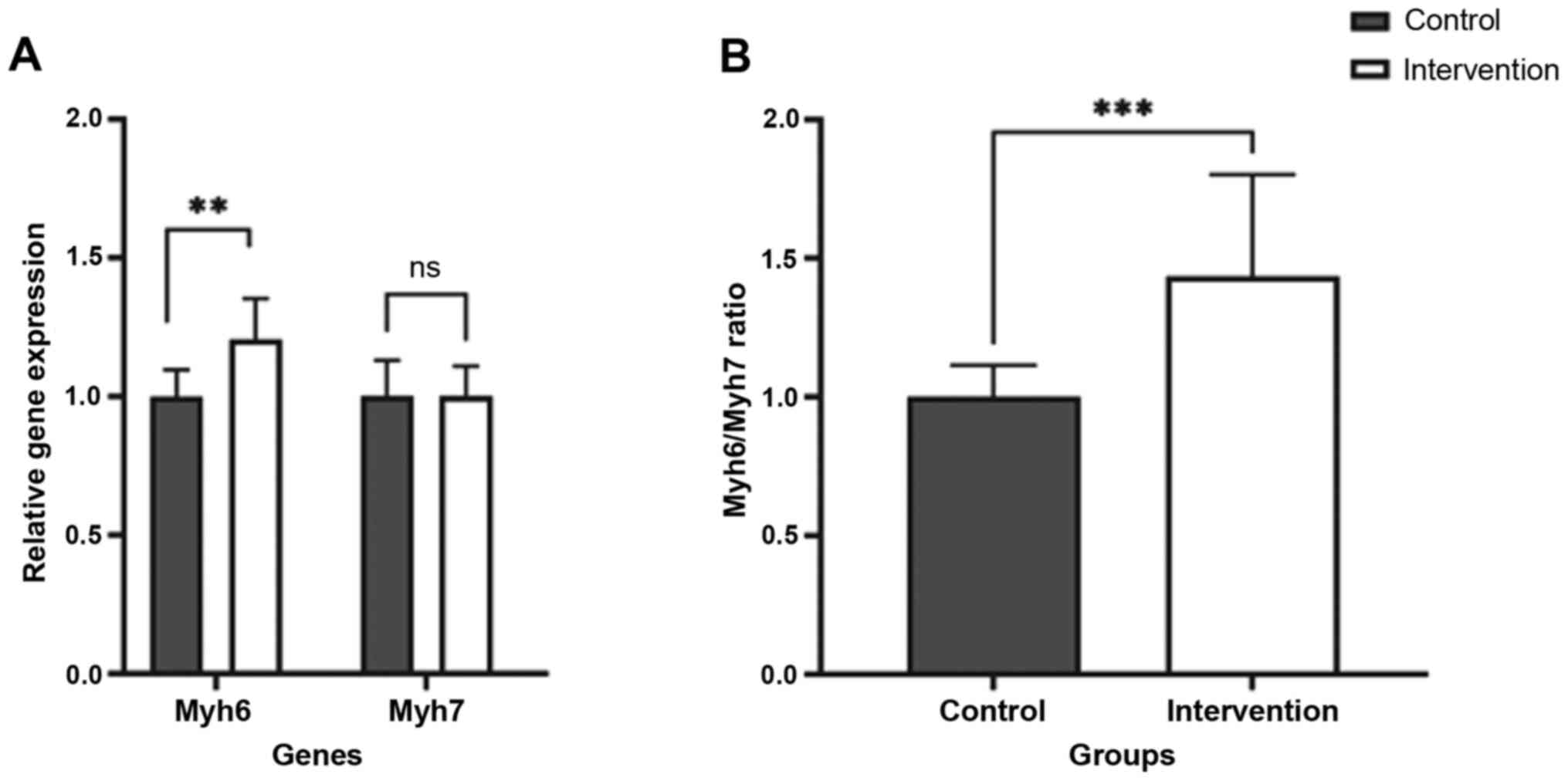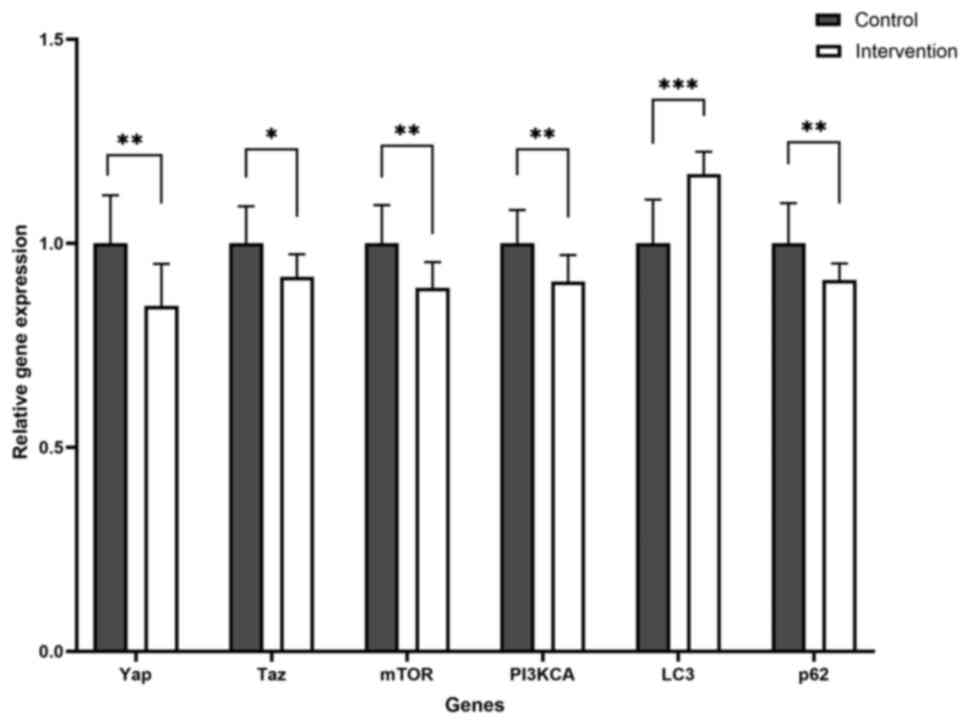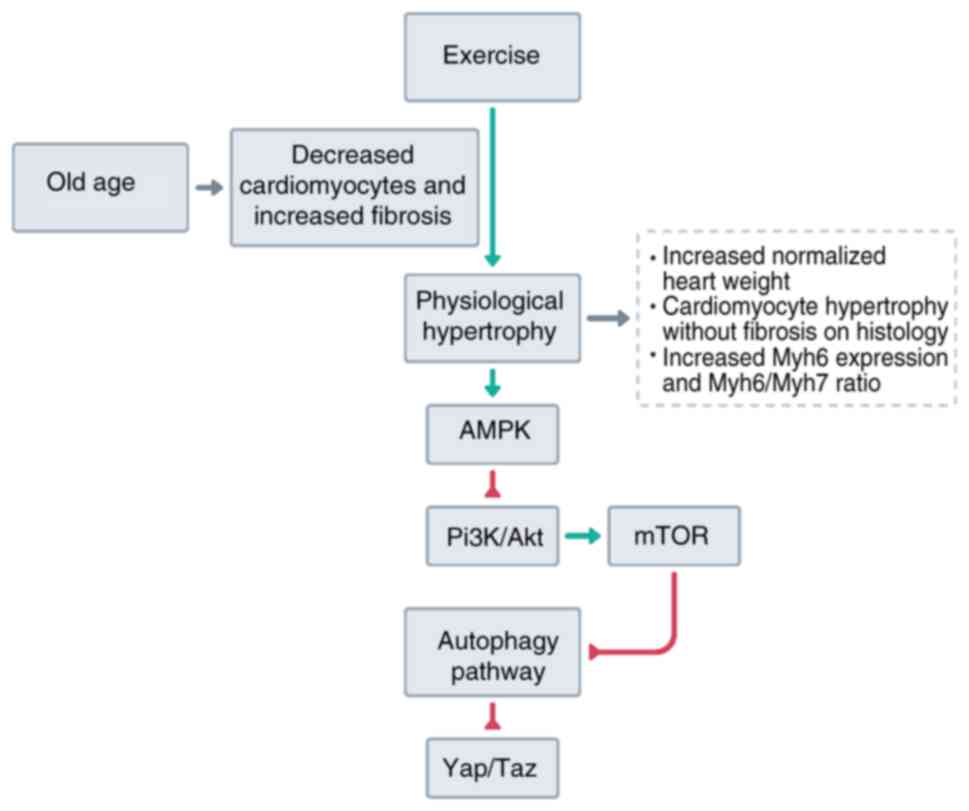|
1
|
Steverson M: Ageing and health. World
Health Organization, Geneva, 2022. https://www.who.int/news-room/fact-sheets/detail/ageing-and-health#:~:text=At%20this%20time%20the%20share,2050%20to%20reach%20426%20million.
Accessed April 18, 2024.
|
|
2
|
Marengoni A, Angleman S, Melis R,
Mangialasche F, Karp A, Garmen A, Meinow B and Fratiglioni L: Aging
with multimorbidity: A systematic review of the literature. Ageing
Res Rev. 10:430–439. 2011.PubMed/NCBI View Article : Google Scholar
|
|
3
|
North BJ and Sinclair DA: The Intersection
between aging and cardiovascular disease. Circ Res. 110:1097–1108.
2012.PubMed/NCBI View Article : Google Scholar
|
|
4
|
Paneni F, Diaz Cañestro C, Libby P,
Lüscher TF and Camici GG: The aging cardiovascular system:
Understanding it at the cellular and clinical levels. J Am Coll
Cardiol. 69:1952–1967. 2017.PubMed/NCBI View Article : Google Scholar
|
|
5
|
Eckstrom E, Neukam S, Kalin L and Wright
J: Physical activity and healthy aging. Clin Geriatr Med.
36:671–683. 2020.PubMed/NCBI View Article : Google Scholar
|
|
6
|
Tracy E, Rowe G and LeBlanc AJ: Cardiac
tissue remodeling in healthy aging: The road to pathology. Am J
Physiol Cell Physiol. 319:C166–C182. 2020.PubMed/NCBI View Article : Google Scholar
|
|
7
|
Nakou ES, Parthenakis FI, Kallergis EM,
Marketou ME, Nakos KS and Vardas PE: Healthy aging and myocardium:
A complicated process with various effects in cardiac structure and
physiology. Int J Cardiol. 209:167–175. 2016.PubMed/NCBI View Article : Google Scholar
|
|
8
|
Park JH, Moon JH, Kim HJ, Kong MH and Oh
YH: Sedentary lifestyle: Overview of updated evidence of potential
health risks. Korean J Fam Med. 41:365–373. 2020.PubMed/NCBI View Article : Google Scholar
|
|
9
|
Taylor L: Third of adults are not getting
enough physical activity, says WHO. BMJ. 385(q1428)2024.PubMed/NCBI View Article : Google Scholar
|
|
10
|
Xu L, Li T, He W, Cao D, Wu C and Qin L:
Prevalence of sufficient physical activity among general adult
population and sub-populations with chronic conditions or
disability in the USA. Eur J Public Health. 33:891–896.
2023.PubMed/NCBI View Article : Google Scholar
|
|
11
|
Wei X, Liu X and Rosenzweig A: What do we
know about the cardiac benefits of exercise? Trends Cardiovasc Med.
25:529–536. 2015.PubMed/NCBI View Article : Google Scholar
|
|
12
|
Platt C, Houstis N and Rosenzweig A: Using
exercise to measure and modify cardiac function. Cell Metab.
21:227–236. 2015.PubMed/NCBI View Article : Google Scholar
|
|
13
|
Nelson ME, Rejeski WJ, Blair SN, Duncan
PW, Judge JO, King AC, Macera CA and Castaneda-Sceppa C: Physical
activity and public health in older adults: Recommendation from the
American college of sports medicine and the American heart
association. Med Sci Sports Exerc. 39:1435–1445. 2007.PubMed/NCBI View Article : Google Scholar
|
|
14
|
Lane-Cordova AD, Jerome GJ, Paluch AE,
Bustamante EE, LaMonte MJ, Pate RR, Weaver RG, Webber-Ritchey KJ
and Gibbs BB: Committee on Physical Activity of the American Heart
Association Council on Lifestyle and Cardiometabolic Health.
Supporting physical activity in patients and populations during
life events and transitions: A scientific statement from the
American heart association. Circulation. 145(e128)2022.PubMed/NCBI View Article : Google Scholar
|
|
15
|
Fulghum K and Hill BG: Metabolic
mechanisms of exercise-induced cardiac remodeling. Front Cardiovasc
Med. 5(127)2018.PubMed/NCBI View Article : Google Scholar
|
|
16
|
Aman Y, Schmauck-Medina T, Hansen M,
Morimoto RI, Simon AK, Bjedov I, Palikaras K, Simonsen A, Johansen
T, Tavernarakis N, et al: Autophagy in healthy aging and disease.
Nat Aging. 1:634–650. 2021.PubMed/NCBI View Article : Google Scholar
|
|
17
|
Shirakabe A, Ikeda Y, Sciarretta S,
Zablocki DK and Sadoshima J: Aging and autophagy in the heart. Circ
Res. 118:1563–1576. 2016.PubMed/NCBI View Article : Google Scholar
|
|
18
|
Kaushik S, Tasset I, Arias E, Pampliega O,
Wong E, Martinez-Vicente M and Cuervo AM: Autophagy and the
hallmarks of aging. Ageing Res Rev. 72(101468)2021.PubMed/NCBI View Article : Google Scholar
|
|
19
|
Sanjaya A, Lesmana R, Goenawan H, Setiawan
I, Sylviana N, Pratiwi YS and Dewi FN: The functional relationship
of Yap/Taz with autophagy functions in sarcopenia associated with
aging. Nutr Healthy Aging. 8:31–39. 2023.
|
|
20
|
Christoper A, Herman H, Abdulah R,
Zulhendri F, Sanjaya A and Lesmana R: Physiological roles of Hippo
signaling pathway and autophagy in dementia. Curr Aging Sci.
16:112–124. 2023.PubMed/NCBI View Article : Google Scholar
|
|
21
|
Wang D, He J, Huang B, Liu S, Zhu H and Xu
T: Emerging role of the Hippo pathway in autophagy. Cell Death Dis.
11(880)2020.PubMed/NCBI View Article : Google Scholar
|
|
22
|
Fischer M, Rikeit P, Knaus P and Coirault
C: YAP-mediated mechanotransduction in skeletal muscle. Front
Physiol. 7(41)2016.PubMed/NCBI View Article : Google Scholar
|
|
23
|
Watt KI, Turner BJ, Hagg A, Zhang X, Davey
JR, Qian H, Beyer C, Winbanks CE, Harvey KF and Gregorevic P: The
Hippo pathway effector YAP is a critical regulator of skeletal
muscle fibre size. Nat Commun. 6(6048)2015.PubMed/NCBI View Article : Google Scholar
|
|
24
|
Judson RN, Gray SR, Walker C, Carroll AM,
Itzstein C, Lionikas A, Zammit PS, De Bari C and Wackerhage H:
Constitutive expression of Yes-associated protein (Yap) in adult
skeletal muscle fibres induces muscle atrophy and myopathy. PLoS
One. 8(e59622)2013.PubMed/NCBI View Article : Google Scholar
|
|
25
|
von Gise A, Lin Z, Schlegelmilch K, Honor
LB, Pan GM, Buck JN, Ma Q, Ishiwata T, Zhou B, Camargo FD and Pu
WT: YAP1, the nuclear target of Hippo signaling, stimulates heart
growth through cardiomyocyte proliferation but not hypertrophy.
Proc Natl Acad Sci USA. 109:2394–2399. 2012.PubMed/NCBI View Article : Google Scholar
|
|
26
|
Del Re DP, Yang Y, Nakano N, Cho J, Zhai
P, Yamamoto T, Zhang N, Yabuta N, Nojima H, Pan D and Sadoshima J:
Yes-associated protein isoform 1 (Yap1) promotes cardiomyocyte
survival and growth to protect against myocardial ischemic injury.
J Biol Chem. 288:3977–3988. 2013.PubMed/NCBI View Article : Google Scholar
|
|
27
|
Heallen T, Zhang M, Wang J,
Bonilla-Claudio M, Klysik E, Johnson RL and Martin JF: Hippo
pathway inhibits Wnt signaling to restrain cardiomyocyte
proliferation and heart size. Science. 332:458–561. 2011.PubMed/NCBI View Article : Google Scholar
|
|
28
|
Wang P, Wang M, Hu Y, Chen J, Cao Y, Liu
C, Wu Z, Shen J, Lu J and Liu P: Isorhapontigenin protects against
doxorubicin-induced cardiotoxicity via increasing YAP1 expression.
Acta Pharm Sin B. 11:680–693. 2021.PubMed/NCBI View Article : Google Scholar
|
|
29
|
Yue P, Zhang Y, Liu L, Zhou K, Xia S, Peng
M, Yan H, Tang X, Chen Z, Zhang D, et al: Yap1 modulates
cardiomyocyte hypertrophy via impaired mitochondrial biogenesis in
response to chronic mechanical stress overload. Theranostics.
12:7009–7031. 2022.PubMed/NCBI View Article : Google Scholar
|
|
30
|
Strait JB and Lakatta EG: Aging-associated
cardiovascular changes and their relationship to heart failure.
Heart Fail Clin. 8:143–164. 2012.PubMed/NCBI View Article : Google Scholar
|
|
31
|
Sheydina A, Riordon DR and Boheler KR:
Molecular mechanisms of cardiomyocyte aging. Clin Sci (Lond).
121:315–329. 2011.PubMed/NCBI View Article : Google Scholar
|
|
32
|
Zech ATL, Singh SR, Schlossarek S and
Carrier L: Autophagy in cardiomyopathies. Biochim Biophys Acta Mol
Cell Res. 1867(118432)2020.PubMed/NCBI View Article : Google Scholar
|
|
33
|
Singh SR, Zech ATL, Geertz B,
Reischmann-Düsener S, Osinska H, Prondzynski M, Krämer E, Meng Q,
Redwood C, van der Velden J, et al: Activation of autophagy
ameliorates cardiomyopathy in Mybpc3-targeted knockin mice. Circ
Heart Fail. 10(e004140)2017.PubMed/NCBI View Article : Google Scholar
|
|
34
|
Gatica D, Chiong M, Lavandero S and
Klionsky DJ: Molecular mechanisms of autophagy in the
cardiovascular system. Circ Res. 116:456–467. 2015.PubMed/NCBI View Article : Google Scholar
|
|
35
|
Sengupta P: The laboratory rat: Relating
its age with human's. Int J Prev Med. 4:624–630. 2013.PubMed/NCBI
|
|
36
|
Lesmana R, Iwasaki T, Iizuka Y, Amano I,
Shimokawa N and Koibuchi N: The change in thyroid hormone signaling
by altered training intensity in male rat skeletal muscle. Endocr
J. 63:727–738. 2016.PubMed/NCBI View Article : Google Scholar
|
|
37
|
Gunadi JW, Tarawan VM, Setiawan I, Lesmana
R, Wahyudianingsih R and Supratman U: Cardiac hypertrophy is
stimulated by altered training intensity and correlates with
autophagy modulation in male Wistar rats. BMC Sports Sci Med
Rehabil. 11(9)2019.PubMed/NCBI View Article : Google Scholar
|
|
38
|
Yin FC, Spurgeon HA, Rakusan K, Weisfeldt
ML and Lakatta EG: Use of tibial length to quantify cardiac
hypertrophy: Application in the aging rat. Am J Physiol.
243:H941–H947. 1982.PubMed/NCBI View Article : Google Scholar
|
|
39
|
Kirby TJ, Lee JD, England JH, Chaillou T,
Esser KA and McCarthy JJ: Blunted hypertrophic response in aged
skeletal muscle is associated with decreased ribosome biogenesis. J
Appl Physiol (1985). 119:321–327. 2015.PubMed/NCBI View Article : Google Scholar
|
|
40
|
Dai DF, Chen T, Johnson SC, Szeto H and
Rabinovitch PS: Cardiac aging: From molecular mechanisms to
significance in human health and disease. Antioxid Redox Signal.
16:1492–1526. 2012.PubMed/NCBI View Article : Google Scholar
|
|
41
|
Shimizu I and Minamino T: Physiological
and pathological cardiac hypertrophy. J Mol Cell Cardiol.
97:245–462. 2016.PubMed/NCBI View Article : Google Scholar
|
|
42
|
Gupta MP: Factors controlling cardiac
myosin-isoform shift during hypertrophy and heart failure. J Mol
Cell Cardiol. 43:388–403. 2007.PubMed/NCBI View Article : Google Scholar
|
|
43
|
Miyata S, Minobe W, Bristow MR and
Leinwand LA: Myosin heavy chain isoform expression in the failing
and nonfailing human heart. Circ Res. 86:386–390. 2000.PubMed/NCBI View Article : Google Scholar
|
|
44
|
James J, Hor K, Moga MA, Martin LA and
Robbins J: Effects of myosin heavy chain manipulation in
experimental heart failure. J Mol Cell Cardiol. 48:999–1006.
2010.PubMed/NCBI View Article : Google Scholar
|
|
45
|
Zhang N, Zhang Y, Xu J, Wang P, Wu B, Lu
S, Lu X, You S, Huang X, Li M, et al: α-myosin heavy chain
lactylation maintains sarcomeric structure and function and
alleviates the development of heart failure. Cell Res. 33:679–698.
2023.PubMed/NCBI View Article : Google Scholar
|
|
46
|
Van Driest SL, Jaeger MA, Ommen SR, Will
ML, Gersh BJ, Tajik AJ and Ackerman MJ: Comprehensive analysis of
the beta-myosin heavy chain gene in 389 unrelated patients with
hypertrophic cardiomyopathy. J Am Coll Cardiol. 44:602–610.
2004.PubMed/NCBI View Article : Google Scholar
|
|
47
|
McNally EM: Beta-myosin heavy chain gene
mutations in familial hypertrophic cardiomyopathy: The usual
suspect? Circ Res. 90:246–247. 2002.PubMed/NCBI
|
|
48
|
Lankford EB, Epstein ND, Fananapazir L and
Sweeney HL: Abnormal contractile properties of muscle fibers
expressing beta-myosin heavy chain gene mutations in patients with
hypertrophic cardiomyopathy. J Clin Invest. 95:1409–1414.
1995.PubMed/NCBI View Article : Google Scholar
|
|
49
|
Wang K, Deng Y and Xiao H: Exercise and
cardiac fibrosis. Curr Opin Physiol. 31(100630)2023.
|
|
50
|
Rao Z, Wang S, Bunner WP, Chang Y and Shi
R: Exercise induced right ventricular fibrosis is associated with
myocardial damage and inflammation. Korean Circ J. 48:1014–1024.
2018.PubMed/NCBI View Article : Google Scholar
|
|
51
|
Lu L, Guo J, Hua Y, Huang K, Magaye R,
Cornell J, Kelly DJ, Reid C, Liew D, Zhou Y, et al: Cardiac
fibrosis in the ageing heart: Contributors and mechanisms. Clin Exp
Pharmacol Physiol. 44 (Suppl 1):S55–S63. 2017.PubMed/NCBI View Article : Google Scholar
|
|
52
|
Frangogiannis NG: Cardiac fibrosis.
Cardiovasc Res. 117:1450–1488. 2021.PubMed/NCBI View Article : Google Scholar
|
|
53
|
Lakhan SE and Harle L: Cardiac fibrosis in
the elderly, normotensive athlete: Case report and review of the
literature. Diagn Pathol. 3(12)2008.PubMed/NCBI View Article : Google Scholar
|
|
54
|
Hong Y, Yang AL, Wong JKS, Masodsai K, Lee
SD and Lin YY: Exercise intervention prevents early aged
hypertension-caused cardiac dysfunction through inhibition of
cardiac fibrosis. Aging (Albany NY). 14:4390–4401. 2022.PubMed/NCBI View Article : Google Scholar
|
|
55
|
Cui X, Wang K, Zhang J and Cao ZB: Aerobic
exercise ameliorates myocardial fibrosis via affecting vitamin D
receptor and transforming growth factor-β1 signaling in vitamin
D-deficient mice. Nutrients. 15(741)2023.PubMed/NCBI View Article : Google Scholar
|
|
56
|
Xin M, Kim Y, Sutherland LB, Murakami M,
Qi X, McAnally J, Porrello ER, Mahmoud AI, Tan W, Shelton JM, et
al: Hippo pathway effector Yap promotes cardiac regeneration. Proc
Natl Acad Sci USA. 110:13839–13844. 2013.PubMed/NCBI View Article : Google Scholar
|
|
57
|
Boogerd CJ, Perini I, Kyriakopoulou E, Han
SJ, La P, van der Swaan B, Berkhout JB, Versteeg D,
Monshouwer-Kloots J and van Rooij E: Cardiomyocyte proliferation is
suppressed by ARID1A-mediated YAP inhibition during cardiac
maturation. Nat Commun. 14(4716)2023.PubMed/NCBI View Article : Google Scholar
|
|
58
|
Flinn MA, Link BA and O'Meara CC: Upstream
regulation of the Hippo-Yap pathway in cardiomyocyte regeneration.
Semin Cell Dev Biol. 100:11–19. 2020.PubMed/NCBI View Article : Google Scholar
|
|
59
|
Wang L, Wang J, Cretoiu D, Li G and Xiao
J: Exercise-mediated regulation of autophagy in the cardiovascular
system. J Sport Health Sci. 9:203–210. 2020.PubMed/NCBI View Article : Google Scholar
|
|
60
|
Sasaki Y, Ikeda Y, Iwabayashi M, Akasaki Y
and Ohishi M: The impact of autophagy on cardiovascular senescence
and diseases. Int Heart J. 58:666–673. 2017.PubMed/NCBI View Article : Google Scholar
|
|
61
|
Wu NN, Tian H, Chen P, Wang D, Ren J and
Zhang Y: Physical exercise and selective autophagy: Benefit and
risk on cardiovascular health. Cells. 8(1436)2019.PubMed/NCBI View Article : Google Scholar
|
|
62
|
Dai M and Hillmeister P: Exercise-mediated
autophagy in cardiovascular diseases. Acta Physiol (Oxf).
236(e13890)2022.PubMed/NCBI View Article : Google Scholar
|
|
63
|
Abdellatif M, Sedej S, Carmona-Gutierrez
D, Madeo F and Kroemer G: Autophagy in cardiovascular aging. Circ
Res. 123:803–824. 2018.PubMed/NCBI View Article : Google Scholar
|
|
64
|
Ott C, Jung T, Brix S, John C, Betz IR,
Foryst-Ludwig A, Deubel S, Kuebler WM, Grune T, Kintscher U and
Grune J: Hypertrophy-reduced autophagy causes cardiac dysfunction
by directly impacting cardiomyocyte contractility. Cells.
10(805)2021.PubMed/NCBI View Article : Google Scholar
|
|
65
|
Taneike M, Yamaguchi O, Nakai A, Hikoso S,
Takeda T, Mizote I, Oka T, Tamai T, Oyabu J, Murakawa T, et al:
Inhibition of autophagy in the heart induces age-related
cardiomyopathy. Autophagy. 6:600–606. 2010.PubMed/NCBI View Article : Google Scholar
|
|
66
|
Yan Z, Kronemberger A, Blomme J, Call JA,
Caster HM, Pereira RO, Zhao H, de Melo VU, Laker RC, Zhang M and
Lira VA: Exercise leads to unfavourable cardiac remodelling and
enhanced metabolic homeostasis in obese mice with cardiac and
skeletal muscle autophagy deficiency. Sci Rep.
7(7894)2017.PubMed/NCBI View Article : Google Scholar
|
|
67
|
Watson K and Baar K: mTOR and the health
benefits of exercise. Semin Cell Dev Biol. 36:130–139.
2014.PubMed/NCBI View Article : Google Scholar
|
|
68
|
Sciarretta S, Volpe M and Sadoshima J:
Mammalian target of rapamycin signaling in cardiac physiology and
disease. Circ Res. 114:549–564. 2014.PubMed/NCBI View Article : Google Scholar
|
|
69
|
Song Z, Moore DR, Hodson N, Ward C, Dent
JR, O'Leary MF, Shaw AM, Hamilton DL, Sarkar S, Gangloff YG, et al:
Resistance exercise initiates mechanistic target of rapamycin
(mTOR) translocation and protein complex co-localisation in human
skeletal muscle. Sci Rep. 7(5028)2017.PubMed/NCBI View Article : Google Scholar
|
|
70
|
Langer HT, West D, Senden J, Spuler S, van
Loon LJC and Baar K: Myofibrillar protein synthesis rates are
increased in chronically exercised skeletal muscle despite
decreased anabolic signaling. Sci Rep. 12(7553)2022.PubMed/NCBI View Article : Google Scholar
|
|
71
|
Gao L, Liu F and Liu R: The The mechanism
of aerobic exercise regulating the PI3K/Akt-mTOR signaling pathway
intervenes in hippocampal neuronal apoptosis in vascular dementia
rats. Int J Environ Res Public Health. 20(1893)2023.PubMed/NCBI View Article : Google Scholar
|














